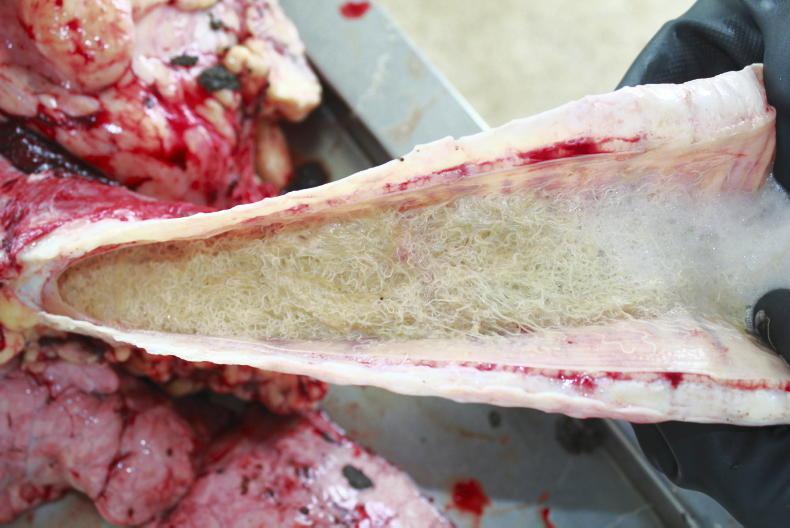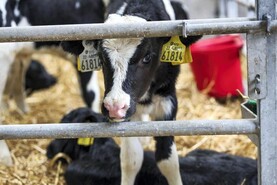It has been a dry summer in many parts of Ireland this year, which generally reduces the risk of internal parasites, but lungworm can still be problematic, particularly a few weeks after rain.
Lungworm outbreaks can be very unpredictable but usually arise late in the summer to autumn season. Calves are most at risk and should be closely monitored and treated if showing clinical signs.
Initial clinical signs may be an increased breathing rate or difficulty breathing, but coughing is usually the first sign that is noticed. These signs can be more noticeable when animals are being moved.
The coughing can develop into pneumonia and, due to lung damage, some animals may take a long time to recover even after wormer treatment.
Dairy cows can show a drop in milk yield during an outbreak, but this can have other causes and should be investigated.
Calves with a lungworm infection may have an increased susceptibility to other respiratory infections caused by viruses and bacteria, which can be problematic for calves if they are already under stress such as at transport, weaning, castration or going into housing.
Dung samples are not always helpful to diagnose lungworm and a negative test does not rule out a lungworm infection because the immature larval stages of the worm can cause clinical signs before they are present in dung.
Monitoring
High-risk animals should be closely monitored for signs of coughing at grass and dosed immediately if lungworm is suspected.
Cattle develop immunity to lungworm by their second or third grazing season provided they have received adequate exposure to the worms. This immunity is shortlived and will wane over time without follow-up exposure, which can lead to cows developing clinical signs.
A long housing period combined with persistent wormers, for example, may prevent the natural boost needed to maintain immunity.
Vaccination should be considered where lungworm is a repeated problem.
This can be given to calves or yearlings before the grazing season, to returning stock or as booster vaccinations for older animals. However, vaccinating spring-born calves can be a challenge as they need two vaccine doses before turnout.

Lungworm in trachea.
Anthelmintic treatments can interfere with vaccine effectiveness and should not be given at or before vaccination.
While it has been a dry summer in many parts, the recent rains and mild temperatures provide ideal conditions for internal parasites. Lungworm and stomach/gut worm risk will increase.
Calves should be monitored closely for signs of gut worm and lungworm such as lacking thrive, scour and coughing.
Cows may be at risk of grass tetany (magnesium deficiency), particularly if they are grazing lush pastures, and may need supplementation.
Preventing disease through vaccine is cost-effective and saves labour looking after sick calves.
Scour vaccines given to cows pre-calving will protect calves and respiratory vaccines for calves should be given prior to housing.
For drying off cows this season, your veterinary practitioner must use a selective approach to dry cow therapy due to a change in legislation. This means some animals will be treated with antibiotic tubes, while others may only receive a teat sealant and the vet will need more information such as records of mastitis events or milk recording data.
As we prepare for drying-off this autumn, Animal Health Ireland in partnership with Teagasc and in conjunction with the dairy processors and the Department of Agriculture, Food and the Marine is running a series of on-farm events around the country in October.
The purpose of these events is to showcase best practice around drying off and assist farmers with selective drying off strategies in light of the changes to the legislation with regard to the use of antibiotics at drying off.
All events start at 11am.
Monday 3 October: Patrick and Paula O’Hanlon, Dooncaha House, Tarbert, Co Kerry. V31 YC57. Tuesday 4 October: Paddy and Carmel Harvey Brisla, Cooraclare, Kilrush, Co Clare. V15 NY02. Wednesday 5 October: Peter Clarke Shannonhall Farm, Shannonhall, Ballycommon, Co Tipperary. E45 A584. Thursday 6 October: Gavin and Declan Dower, Creggs, Clashmore, Co Waterford. P36 ED70. Friday 7 October: Michael and Enda Horgan, Fringestown, Castletown, Navan, Co Meath. C15 K120. Monday 10 October: Clonakilty Agricultural College, Darrara, Clonakility, Co Cork. P85 EK80. Tuesday 11 October: John Fitzgerald and Vincent Hennessy, Beechfield Farm, Dromore, Mallow, Co Cork. P51 VR60.Wednesday 12 October: Oliver Lynch Coolnaclehy, Skibbereen, Co Cork. P81 X208.Thursday 13 October: John and Martina Lonergan, Dranganmore, Cahir, Co Tipperary. E21 V380. Friday 14 October: Denis, Nora and Michael Lordan, Farnalough, Newcestown, Bandon, Co Cork. P72 KF22. Monday 17 October: John Russell Ballylawn, Manorcunningham, Letterkenny, Co Donegal. F92 Y838. Tuesday 18 October: Killian Brennan, Kilcogy Upper, Co Longford. N39 YY81. Wednesday 19 October: Conor, Grainne and Niall Molony, Clobanna, Thurles, Co Tipperary. E41 KH90.
It has been a dry summer in many parts of Ireland this year, which generally reduces the risk of internal parasites, but lungworm can still be problematic, particularly a few weeks after rain.
Lungworm outbreaks can be very unpredictable but usually arise late in the summer to autumn season. Calves are most at risk and should be closely monitored and treated if showing clinical signs.
Initial clinical signs may be an increased breathing rate or difficulty breathing, but coughing is usually the first sign that is noticed. These signs can be more noticeable when animals are being moved.
The coughing can develop into pneumonia and, due to lung damage, some animals may take a long time to recover even after wormer treatment.
Dairy cows can show a drop in milk yield during an outbreak, but this can have other causes and should be investigated.
Calves with a lungworm infection may have an increased susceptibility to other respiratory infections caused by viruses and bacteria, which can be problematic for calves if they are already under stress such as at transport, weaning, castration or going into housing.
Dung samples are not always helpful to diagnose lungworm and a negative test does not rule out a lungworm infection because the immature larval stages of the worm can cause clinical signs before they are present in dung.
Monitoring
High-risk animals should be closely monitored for signs of coughing at grass and dosed immediately if lungworm is suspected.
Cattle develop immunity to lungworm by their second or third grazing season provided they have received adequate exposure to the worms. This immunity is shortlived and will wane over time without follow-up exposure, which can lead to cows developing clinical signs.
A long housing period combined with persistent wormers, for example, may prevent the natural boost needed to maintain immunity.
Vaccination should be considered where lungworm is a repeated problem.
This can be given to calves or yearlings before the grazing season, to returning stock or as booster vaccinations for older animals. However, vaccinating spring-born calves can be a challenge as they need two vaccine doses before turnout.

Lungworm in trachea.
Anthelmintic treatments can interfere with vaccine effectiveness and should not be given at or before vaccination.
While it has been a dry summer in many parts, the recent rains and mild temperatures provide ideal conditions for internal parasites. Lungworm and stomach/gut worm risk will increase.
Calves should be monitored closely for signs of gut worm and lungworm such as lacking thrive, scour and coughing.
Cows may be at risk of grass tetany (magnesium deficiency), particularly if they are grazing lush pastures, and may need supplementation.
Preventing disease through vaccine is cost-effective and saves labour looking after sick calves.
Scour vaccines given to cows pre-calving will protect calves and respiratory vaccines for calves should be given prior to housing.
For drying off cows this season, your veterinary practitioner must use a selective approach to dry cow therapy due to a change in legislation. This means some animals will be treated with antibiotic tubes, while others may only receive a teat sealant and the vet will need more information such as records of mastitis events or milk recording data.
As we prepare for drying-off this autumn, Animal Health Ireland in partnership with Teagasc and in conjunction with the dairy processors and the Department of Agriculture, Food and the Marine is running a series of on-farm events around the country in October.
The purpose of these events is to showcase best practice around drying off and assist farmers with selective drying off strategies in light of the changes to the legislation with regard to the use of antibiotics at drying off.
All events start at 11am.
Monday 3 October: Patrick and Paula O’Hanlon, Dooncaha House, Tarbert, Co Kerry. V31 YC57. Tuesday 4 October: Paddy and Carmel Harvey Brisla, Cooraclare, Kilrush, Co Clare. V15 NY02. Wednesday 5 October: Peter Clarke Shannonhall Farm, Shannonhall, Ballycommon, Co Tipperary. E45 A584. Thursday 6 October: Gavin and Declan Dower, Creggs, Clashmore, Co Waterford. P36 ED70. Friday 7 October: Michael and Enda Horgan, Fringestown, Castletown, Navan, Co Meath. C15 K120. Monday 10 October: Clonakilty Agricultural College, Darrara, Clonakility, Co Cork. P85 EK80. Tuesday 11 October: John Fitzgerald and Vincent Hennessy, Beechfield Farm, Dromore, Mallow, Co Cork. P51 VR60.Wednesday 12 October: Oliver Lynch Coolnaclehy, Skibbereen, Co Cork. P81 X208.Thursday 13 October: John and Martina Lonergan, Dranganmore, Cahir, Co Tipperary. E21 V380. Friday 14 October: Denis, Nora and Michael Lordan, Farnalough, Newcestown, Bandon, Co Cork. P72 KF22. Monday 17 October: John Russell Ballylawn, Manorcunningham, Letterkenny, Co Donegal. F92 Y838. Tuesday 18 October: Killian Brennan, Kilcogy Upper, Co Longford. N39 YY81. Wednesday 19 October: Conor, Grainne and Niall Molony, Clobanna, Thurles, Co Tipperary. E41 KH90. 






 This is a subscriber-only article
This is a subscriber-only article










SHARING OPTIONS: